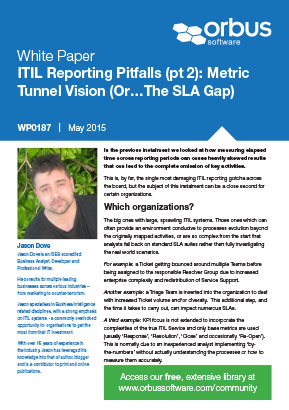Part 1 of Jason Dove's ITIL Reporting Pitfalls defined the most damaging reporting gotcha - how measuring elapsed time across reporting periods can cause heavily skewed results. This instalment focuses on a close second; the pitfall that arises when ITIL reporting focuses purely on SLA metrics, without including the full picture required for context.
Part 1 of Jason Dove's ITIL Reporting Pitfalls defined the most damaging reporting gotcha - how measuring elapsed time across reporting periods can cause heavily skewed results.
This instalment focuses on a close second; the pitfall that arises when ITIL reporting focuses purely on SLA metrics, without including the full picture required for context.
The big organizations with large, sprawling ITIL systems often provide an environment conducive to processes evolution beyond the originally mapped activities, or are so complex from the start that analysts fall back on standard SLA suites rather than fully investigating the real world scenarios.
For example: a Ticket getting bounced around multiple Teams before being assigned to the responsible Resolver Group due to increased enterprise complexity and redistribution of Service Support.
Another example: a Triage Team is inserted into the organization to deal with increased Ticket volume and/or diversity. This additional step, and the time it takes to carry out, can impact numerous SLAs.
A third example: KPI focus is not extended to incorporate the complexities of the true ITIL Service and only base metrics are used (usually ‘Response’, ‘Resolution’, ‘Close’ and occasionally ‘Re-Open’). This is normally due to an inexperienced analyst implementing ‘bythe-numbers’ without actually understanding the processes or how to measure them accurately.
Login to continue reading or register now to download the ebook.
